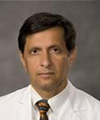Hepatology
Liver Fibrosis
Halting the Progression of Liver Disease in Patients With Metabolic Syndrome
Overview
The progression of nonalcoholic fatty liver disease (NAFLD) to its fibrotic forms may be associated with the acceleration of other metabolically driven pathologies, such as cardiovascular disease. In addition to implementing lifestyle changes and encouraging weight loss, new therapies to stem the tide of metabolic-associated fatty liver disease may be on the horizon.
Expert Commentary
Arun J. Sanyal, MD
|
|
“There is an incredible unmet need and an opportunity to develop more integrated and holistic approaches, both for the identification of risk and to evaluate and treat diseases such as NAFLD before they create outcomes.”
Historically, we have recognized that metabolic syndrome and NAFLD share risk factors and that the conditions frequently coexist, so patients with NAFLD might also have type 2 diabetes, obesity, hypertension, dyslipidemia, and coronary artery disease. What has become clear over the last decade is that there is common biology that connects the development of each of these diseases, and the spectrum of disorders that fell under the umbrella term of metabolic syndrome in the past has expanded. NAFLD is now an important part of this larger syndrome, but it is also closely connected to cardiovascular disease, heart failure with preserved ejection fraction, type 2 diabetes, chronic kidney disease, and even possibly Alzheimer’s disease.
This has several implications, one of which is, due to the common biology, if one organ is affected, it is likely that the other organs are affected as well because of systemic metabolically driven inflammation. Another implication is that having the liver disease itself may actually accelerate these related disorders, particularly cardiovascular disease, because the liver is one of the organs that is critically involved in the production of cholesterol and the lipoproteins that contribute to vascular disease and coronary artery disease.
There are challenges in the management of NAFLD, with some being related to silos in medicine that contribute to a fragmentation of care. Specialists are at risk of losing sight of all of the organs that may be injured in a patient with NAFLD. In our best attempts to fix each organ one at a time, we are creating a huge burden of testing and treatment, with the use of specific drugs that are directed at each of the end organs and even often adding multiple drugs for each affected end organ. There is an incredible unmet need and an opportunity to develop more integrated and holistic approaches, both for the identification of risk and to evaluate and treat diseases such as NAFLD before they create outcomes.
Interventions to slow or halt the progression of NAFLD are available right now. The optimization of lifestyle is a critical first step, but this intervention is often sidelined, for a variety of reasons. Most clinicians will agree that, while lifestyle interventions such as weight loss and the optimization of physical fitness are desired goals, most patients are unlikely to achieve these goals. So, the focus becomes more on pharmacotherapy. In the future, a more detailed assessment of why people do not achieve and maintain weight loss is going to be a very critical first step, because one size does not fit all in this regard.
For those patients who already have significant liver injury, vitamin E remains a potential treatment option that is supported by the evidence. Looking to the horizon, data with glucagon-like peptide 1 (GLP-1) receptor agonists appear very promising in nonalcoholic steatohepatitis (NASH). In addition to indications in type 2 diabetes and chronic weight management, GLP-1 receptor agonists have been shown to improve all-cause mortality and cardiovascular outcomes among patients with diabetes and advanced cardiovascular risk profiles. Our recent paper from The New England Journal of Medicine showed a resolution of NASH, without any worsening of fibrosis, in approximately 59% of patients who were treated with semaglutide 0.4 mg per day. If the ongoing phase 3 trial with GLP-1 therapy can confirm these and other findings, then I think that this would be a breakthrough.
Several other therapies are in development and look very promising. For instance, thyroid hormone receptor β agonists are relatively liver specific and promote the optimization of fat in the liver. The existing data on lipid profile improvements with these agents, which should translate into improved cardiovascular outcomes, along with good tolerability and the rapidity with which they effect the liver and improve liver enzymes, make this a very promising target for NAFLD therapy. Further, pioglitazone, a peroxisome proliferator-activated receptor (PPAR) agonist, is being evaluated in patients with significant liver disease with bridging fibrosis who are on the cusp of developing cirrhosis. And some of the early data on lanifibranor, a pan-PPAR agonist, have shown that it improves NASH and reduces fibrosis; phase 3 trials are ongoing. Lastly, arachidyl amido cholanoic acid (Aramchol) also reduces de novo lipogenesis, has an impact on metabolic reprogramming, has been shown to improve metabolic-associated fatty liver disease and NASH, and has a modest effect on fibrosis.
References
Abdel-Maboud M, Menshawy A, Menshawy E, Emara A, Alshandidy M, Eid M. The efficacy of vitamin E in reducing non-alcoholic fatty liver disease: a systematic review, meta-analysis, and meta-regression. Therap Adv Gastroenterol. 2020;13:1756284820974917. doi:10.1177/1756284820974917
Bhattacharya D, Basta B, Mato JM, et al. Aramchol downregulates stearoyl CoA-desaturase 1 in hepatic stellate cells to attenuate cellular fibrogenesis. JHEP Rep. 2021;3(3):100237. doi:10.1016/j.jhepr.2021.100237
Dharmalingam M, Yamasandhi PG. Nonalcoholic fatty liver disease and type 2 diabetes mellitus. Indian J Endocrinol Metab. 2018;22(3):421-428. doi:10.4103/ijem.IJEM_585_17
Kasper P, Martin A, Lang S, et al. NAFLD and cardiovascular diseases: a clinical review. Clin Res Cardiol. 2021;110(7):921-937. doi:10.1007/s00392-020-01709-7
Moolla A, Motohashi K, Marjot T, et al. A multidisciplinary approach to the management of NAFLD is associated with improvement in markers of liver and cardio-metabolic health. Frontline Gastroenterol. 2019;10(4):337-346. doi:10.1136/flgastro-2018-101155
Newsome PN, Buchholtz K, Cusi K, et al; NN9931-4296 Investigators. A placebo-controlled trial of subcutaneous semaglutide in nonalcoholic steatohepatitis. N Engl J Med. 2021;384(12):1113-1124. doi:10.1056/NEJMoa2028395
Ratziu V, de Guevara L, Safadi R, et al; ARREST Investigator Study Group. Aramchol in patients with nonalcoholic steatohepatitis: a randomized, double-blind, placebo-controlled phase 2b trial. Nat Med. 2021;27(10):1825-1835. doi:10.1038/s41591-021-01495-3
Sanyal AJ, Van Natta ML, Clark J, et al; NASH Clinical Research Network (CRN). Prospective study of outcomes in adults with nonalcoholic fatty liver disease. N Engl J Med. 2021;385(17):1559-1569. doi:10.1056/NEJMoa2029349











